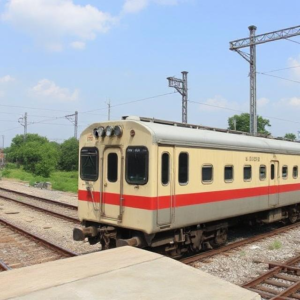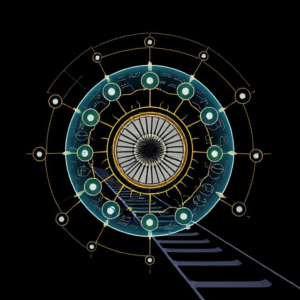Indian Railways is always looking for ways to improve and innovate to make train travel faster, safer, and more comfortable for passengers. Over the years, various new technologies and innovations have been introduced, and the future promises even more exciting advancements. Let me break it down for you in simple terms:
1. Vande Bharat Express: The Next-Gen Train
- What is Vande Bharat Express? This is a high-speed, semi-high-speed train that is designed and manufactured in India. It is also called the Train 18.
- Features:
- Speed: It can travel at speeds of up to 160 km/h (100 mph), which makes it one of the fastest trains in India.
- Modern Design: The train has modern features like automatic doors, comfortable seats, and Wi-Fi connectivity.
- Energy Efficiency: Vande Bharat Express is eco-friendly as it uses energy-efficient features like regenerative braking, which saves energy when slowing down.
- What Makes It Special?
- The train is designed to reduce travel time between major cities, for example, the New Delhi to Varanasi route. It has advanced safety features and is fully air-conditioned, providing a better travel experience.
2. Semi-High-Speed Trains: A Step Toward Faster Travel
- What Are They? These trains are faster than regular trains but not as fast as bullet trains. They can run at speeds of around 160 km/h or more.
- Examples:
- Vande Bharat Express is one example, but there are other projects in the works, like Mumbai-Ahmedabad routes that will have semi-high-speed trains.
- Benefits: These trains will significantly reduce travel time between cities, making long-distance travel faster and more comfortable.

3. Bullet Trains: The Future of Fast Travel
- What Are Bullet Trains? These are super-fast trains that can travel at speeds of over 300 km/h (186 mph), which is much faster than regular trains.
- The Mumbai-Ahmedabad Bullet Train Project: This is one of India’s most ambitious projects, where the government is working on building a high-speed rail corridor between Mumbai and Ahmedabad.
- Technology: Japan’s Shinkansen technology is being used to build India’s first bullet train, which will revolutionize long-distance travel.
- Why It’s Important: Bullet trains will make travel between cities much faster (for example, the trip between Mumbai and Ahmedabad, which currently takes over 6 hours, will be reduced to just about 2 hours).
4. Automatic Train Collision Avoidance System (Kavach)
- What is Kavach? Kavach is a train protection system that helps prevent accidents. It uses sensors and technology to automatically stop a train if there is a risk of a collision with another train on the same track.
- How Does It Work? If a driver does not respond to a signal or if there’s a train ahead on the track, Kavach automatically applies the brakes. This system will be implemented on high-density routes and can save lives by reducing accidents caused by human error.
5. Artificial Intelligence (AI) and Big Data in Railways
- What is AI and Big Data? AI and Big Data are technologies used to analyze huge amounts of data and make decisions. In the context of railways, AI and Big Data are used to:
- Monitor train schedules: AI can predict delays and suggest alternative routes in real-time.
- Track condition monitoring: Sensors on trains and tracks send data, which is analyzed to detect problems like cracks or faults in real time. This helps to prevent accidents before they happen.
- Predictive Maintenance: AI can predict when a part of the train or track will fail by analyzing past data, so repairs can be made before a problem occurs, keeping trains running smoothly.
6. Smart Stations and Digital Innovations
- What are Smart Stations? Smart stations use digital technology to make train stations more efficient and passenger-friendly. They use things like:
- Wi-Fi: Passengers can use free internet while waiting.
- Digital Ticketing: You can book and show your tickets on your phone, avoiding the need for paper tickets.
- Smart Platforms: Platforms with digital screens display real-time information about train arrivals and departures, helping passengers stay updated.
- Innovations in Ticketing:
- Paperless Ticketing: You can book and show your train tickets via apps like IRCTC (Indian Railways Catering and Tourism Corporation), avoiding the need for paper tickets.
- QR Code-based Entry: Some stations and trains are adopting QR codes for easy boarding and to avoid long queues.
7. Green Technologies: Making Railways More Eco-Friendly
Indian Railways is working on being more environmentally friendly by adopting new green technologies. Some of these include:
- Solar-Powered Trains: Indian Railways is installing solar panels on the roofs of trains and stations. This is a sustainable way to generate energy, reducing dependency on non-renewable resources.
- Energy-Efficient Trains: New trains are designed to consume less energy, and systems like regenerative braking (which generates power while braking) help reduce energy consumption.
- Electrification: A major project is to electrify all railway lines, reducing the reliance on diesel engines and making trains more eco-friendly.
8. High-Speed Rail Corridors
Apart from the bullet train project, India is planning several high-speed rail corridors across the country. These are specialized tracks designed for trains that run at higher speeds (160-200 km/h). Some upcoming corridors include:
- Delhi-Meerut Corridor
- Mumbai-Pune Corridor
These projects will improve the travel experience by reducing travel time, especially between cities that are far apart.
9. Internet of Things (IoT) and Smart Sensors
- What is IoT? IoT is a network of connected devices that can share information. For Indian Railways, this means:
- Smart Sensors on Tracks: Sensors installed on railway tracks can monitor conditions in real-time. They help detect issues like track damage, wear, or signs of potential problems, allowing for timely repairs.
- Connected Trains: Trains are also being equipped with sensors that provide information about the train’s condition (like engine temperature or brake status), which helps with predictive maintenance.
Conclusion: The Future of Indian Railways
Indian Railways is constantly evolving, with numerous innovations and technologies aimed at improving travel for millions of people. From high-speed trains and driverless technologies to eco-friendly practices and advanced safety systems, the future of Indian Railways looks exciting. These innovations will make travel faster, safer, and more comfortable while also contributing to a more sustainable and efficient transport system.
Would you like to know more about any specific future technology or innovation in Indian Railways?
Keywords: Indian Railways, Railway











